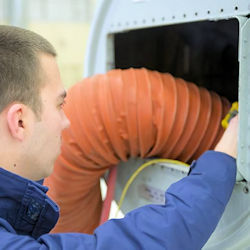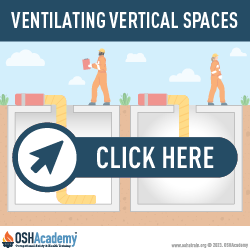Controlling Toxic Atmospheres
Welding, cutting, burning, and continuous brazing generate hazardous fumes and dusts that can be more effectively removed by local exhaust ventilation systems at or near the point of generation.
A control measure effective in preventing toxic hazardous atmospheres from developing in the first place is the use of less toxic products that vaporize less readily. Keep less of the product at the site and always keep containers closed inside the confined space.
Ventilating Confined Spaces
After you determine the confined space contains a harmful atmosphere, the next step is to clear it. Ventilation blows out oxygen-deficient or contaminated atmospheres and replaces harmful vapors with clean, fresh air.

Ventilation helps to:
- provide adequate oxygen to the air in the space
- control atmospheric contaminants
- prevent fire and explosion hazards
- control heat and humidity
When ventilation is used to remove atmospheric contaminants from the confined space, the space should be ventilated until the atmosphere is within the acceptable ranges.
- Ventilate the space thoroughly so that there are no contaminated pockets left, and then test the atmosphere again.
- Ventilate during the occupancy if there is a potential for the atmospheric conditions to move out of the acceptable range.
In spaces that are deep or have areas leading away from the entry point, the atmosphere may be layered or may be different in remote areas. Extend the forced-air ventilation output to the bottom of the confined space to prevent pockets of hazardous atmospheres.
- For these spaces, testing must be done in the area surrounding the worker, which is considered four (4) feet in the direction of travel and to each side.
- If a sample probe is used to do the testing, then the worker must move slowly enough so that testing is completed, keeping the equipment "response time" in mind, before he/she moves into the new area.
When ventilation is not possible or feasible, alternate protective measures or methods to remove air contaminants and protect occupants should be determined by the qualified person before authorizing entry.
Knowledge Check Choose the best answer for the question.
4-4. Once a confined space is determined to contain a harmful atmosphere, what is the next step?
You forgot to answer the question!

